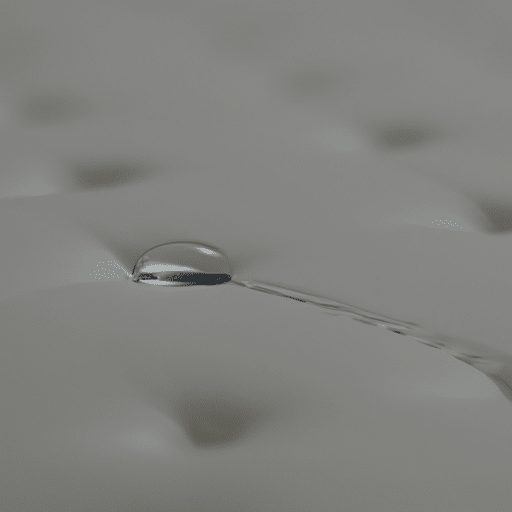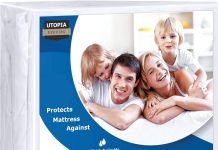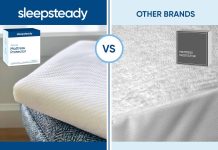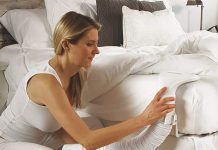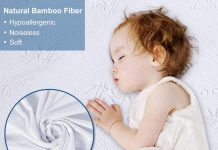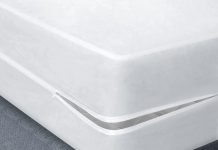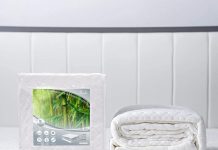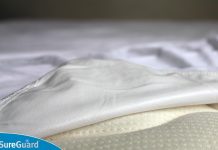Mattress protectors may seem like a simple addition to your bed, but they play a significant role in maintaining the longevity and cleanliness of your mattress. Designed to provide a protective barrier against spills, dirt, and allergens, mattress protectors prevent stains and odors from seeping into the mattress material. Additionally, they act as a shield against dust mites and bed bugs, keeping your sleeping environment healthy and hygienic. In this article, we will explore the various mechanisms behind how mattress protectors work and why they are an essential investment for every bed. Discover how these humble accessories can prolong the life of your mattress while ensuring a comfortable and healthy night’s sleep.
Review contents
What is a Mattress Protector?
Definition
A mattress protector is a removable bedding accessory that is designed to cover and protect your mattress from stains, spills, allergens, dust mites, bed bugs, and other pests. It acts as a barrier between your body and the mattress, extending its lifespan and enhancing sleep comfort.
Materials Used
Mattress protectors are typically made from a variety of materials, including cotton, polyester, or a combination of both. These materials are chosen for their durability, breathability, and ability to repel liquids. Some mattress protectors also feature a waterproof layer, usually made of polyurethane, to provide an extra layer of protection.
Types of Mattress Protectors
Fitted Sheet-style Protectors
Fitted sheet-style mattress protectors are designed to fit over your mattress like a regular fitted sheet. These protectors have elasticated edges that ensure a snug fit and prevent them from slipping or bunching up during the night. They are easy to install and remove, making them a popular choice among users.
Encasement Protectors
Encasement mattress protectors provide complete coverage for your mattress by encasing it entirely. These protectors have a zipper closure that secures the mattress from all sides, effectively sealing it off from any potential threats. This type of protector is particularly beneficial for those who want comprehensive protection against bed bugs and allergens.
Zippered Protectors
Zippered mattress protectors are similar to encasement protectors in terms of providing full coverage for your mattress. However, unlike encasement protectors that enclose the entire mattress, zippered protectors have a zipper that runs along one or more sides of the protector, allowing for easier installation and removal.
Waterproof Protectors
Waterproof mattress protectors are specifically designed to prevent liquids from seeping into your mattress. These protectors feature a waterproof layer that acts as a barrier, effectively repelling spills, stains, and moisture. They are a great option for families with children or pets, or for anyone who wants to keep their mattress clean and hygienic.
Hypoallergenic Protectors
Hypoallergenic mattress protectors are ideal for those who suffer from allergies or have sensitivities to common allergens. These protectors have a tightly woven fabric construction that prevents allergens such as dust mites, pollen, and pet dander from penetrating into the mattress. By creating a hypoallergenic barrier, these protectors can help alleviate allergy symptoms and promote a healthier sleep environment.
Temperature-regulating Protectors
Temperature-regulating mattress protectors are designed to help regulate your body temperature while you sleep. These protectors are made with special fabrics that wick away moisture and promote breathability, keeping you cool and comfortable throughout the night. They are especially beneficial for individuals who tend to get hot or sweat excessively during sleep.
Benefits of Using a Mattress Protector
Protection against Stains and Spills
One of the primary benefits of using a mattress protector is that it provides a protective barrier against stains and spills. Accidents happen, whether it’s spills from beverages, bedwetting incidents, or even pet accidents. With a mattress protector in place, you can easily clean up any mess without worrying about it seeping into your mattress.
Shield from Allergens and Dust Mites
Another important benefit of mattress protectors is their ability to shield your mattress from allergens and dust mites. Dust mites are microscopic creatures that thrive in mattresses and can trigger allergies or worsen asthma symptoms. A mattress protector with a tightly woven fabric construction can effectively prevent these allergens from infiltrating your mattress, providing a healthier sleep environment.
Prolongs Mattress Lifespan
Investing in a high-quality mattress is an important decision, and using a mattress protector can help prolong its lifespan. Regular wear and tear, including body oils, sweat, and dust, can gradually diminish the integrity of your mattress. By adding a protective layer with a mattress protector, you can minimize the accumulation of these factors, ultimately extending the life of your mattress.
Enhances Sleep Comfort
A mattress protector can also enhance sleep comfort by providing an additional layer of cushioning and softness. Some protectors are made with plush materials that add an extra level of comfort to your sleep surface. Additionally, a mattress protector can prevent uncomfortable lumps or bumps from forming on your mattress over time, ensuring a more comfortable and enjoyable sleeping experience.
Prevents Bed Bugs and Other Pests
Bed bugs are a common nuisance that can infest your mattress and cause unsightly bites and itching. Fortunately, mattress protectors, particularly encasement protectors, can act as a barrier and prevent bed bugs from establishing themselves in your mattress. By keeping these pests at bay, a mattress protector helps maintain a clean and pest-free sleep environment.
How Does a Mattress Protector Work?
Creates a Barrier
A mattress protector creates a physical barrier between you and your mattress, preventing any spills, stains, or pests from reaching the mattress surface. By acting as a shield, the protector absorbs any moisture or fluids that may come in contact with it, keeping your mattress clean and dry.
Absorbs Moisture
Mattress protectors, especially those with a waterproof layer, have the ability to absorb moisture and prevent it from penetrating into the mattress. If you accidentally spill a drink or sweat during the night, the protector will absorb the liquid and prevent it from seeping through to your mattress, ultimately protecting it from any damage.
Prevents Allergens
By using a mattress protector with a tightly woven fabric construction, you can effectively prevent allergens such as dust mites, pollen, pet dander, and mold spores from entering your mattress. The microscopic pores in the fabric are small enough to block these allergens, ensuring a healthier and allergy-free sleep environment.
Keeps Bed Bugs Away
Bed bugs are notorious pests that can infest your mattress and cause significant discomfort. However, using an encasement mattress protector with a zipper closure can create an impenetrable barrier against bed bugs. This type of protector fully encloses the mattress, leaving no gaps or openings for the bugs to enter, effectively keeping them at bay.
Choosing the Right Mattress Protector
Size
When choosing a mattress protector, it’s important to consider the size of your mattress. The protector should fit snugly and securely over your mattress without any excess fabric or gaps. Measure the dimensions of your mattress to ensure you select the correct size protector.
Material
Consider the materials used in the mattress protector and choose one that suits your preferences and needs. Cotton protectors are soft, breathable, and ideal for individuals who prefer a more natural feel. Polyester protectors are durable, hypoallergenic, and often more affordable. Some protectors combine both materials for added benefits.
Waterproofing
If you’re concerned about spills or accidents, consider a mattress protector with waterproofing capabilities. Look for a protector with a waterproof layer, such as polyurethane, that prevents liquids from seeping into the mattress. Ensure that the waterproofing does not compromise breathability and comfort.
Breathability
Ensure that the mattress protector allows for proper airflow and heat dissipation. Look for protectors made with breathable materials or those with moisture-wicking properties. This is especially important if you tend to sleep hot or live in a warm climate.
Noise Level
Consider the noise level of the mattress protector. Some protectors may produce a crinkling or rustling sound when you move, which could disrupt your sleep. Opt for protectors that are specifically designed to be noiseless, ensuring a quiet and undisturbed sleep.
Ease of Cleaning
Choose a mattress protector that is easy to clean and maintain. Look for one that is machine washable and dryer safe, as this will make regular cleaning and maintenance a breeze. Some protectors may also be spot cleaned for quick and easy stain removal.
How to Use a Mattress Protector
Step 1: Preparation
Before using a mattress protector, ensure that your mattress is clean and free from any dirt or stains. Vacuum your mattress to remove any dust, debris, or allergens that may be present. This step will help create a clean and hygienic environment for your mattress.
Step 2: Fitting the Protector
Place the mattress protector over your mattress, ensuring that it is centered and aligned correctly. If your protector has elasticated corners or straps, stretch them over the corners of your mattress to secure the protector in place. Smooth out any wrinkles or creases for a neat and snug fit.
Step 3: Securing the Protector
If your mattress protector has a zipper or closure mechanism, zip or fasten it securely to fully encase the mattress. Ensure that the closure is tight and no gaps or openings are left. This step is particularly important for encasement protectors, as it ensures complete protection against pests and allergens.
Maintenance and Cleaning
Regular Cleaning
To maintain the cleanliness of your mattress protector, it is recommended to regularly clean it. Remove any sheets or bedding that may be covering the protector and inspect it for stains or spills. Use a stain remover or mild detergent to spot clean any areas that require attention.
Spot Cleaning
For small stains or spills, spot cleaning is often sufficient. Gently blot the affected area with a cloth or sponge dampened with a mild detergent or stain remover. Avoid scrubbing vigorously, as this may damage the fabric. Allow the spot to air dry completely before reapplying sheets or bedding.
Machine Washing
Most mattress protectors are machine washable, but it’s essential to follow the manufacturer’s instructions for care. Set the washing machine to a gentle or delicate cycle, using cold or warm water. Use a mild detergent and avoid using bleach or harsh chemicals. After the wash cycle is complete, tumble dry the protector on low heat or air dry it.
Drying and Ironing
Ensure that the mattress protector is completely dry before reapplying it to your mattress. If air drying, hang the protector in a well-ventilated area or outdoors, away from direct sunlight. Avoid using a clothes dryer on high heat, as this can potentially damage the protector. Ironing is generally not necessary for mattress protectors, as they are designed to lay flat and smooth on the mattress.
FAQs about Mattress Protectors
Are mattress protectors necessary?
While mattress protectors are not strictly necessary, they offer numerous benefits and can help prolong the life of your mattress. They provide protection against spills, stains, allergens, and pests, ultimately creating a cleaner and healthier sleep environment.
Can mattress protectors make you sweat?
No, mattress protectors themselves do not typically make you sweat. However, some protectors may affect the breathability of your mattress, leading to increased heat retention. If you tend to sleep hot or live in a warm climate, look for a mattress protector that prioritizes breathability and heat dissipation.
Can mattress protectors be used with heated mattress pads?
Yes, mattress protectors can be used in conjunction with heated mattress pads. However, it is essential to choose a protector that is specifically designed to be compatible with heated bedding. Follow the manufacturer’s instructions for both the mattress protector and heated mattress pad to ensure proper usage and safety.
Do mattress protectors make noise?
Not all mattress protectors make noise. Some protectors have noise-reducing properties, allowing for a quiet and undisturbed sleep. Look for protectors that specifically mention noise reduction or those made with noiseless materials to minimize any sound when you move on your mattress.
Which is better: fitted or encasement protectors?
The choice between fitted and encasement protectors ultimately depends on your specific needs and preferences. Fitted sheet-style protectors are easier to install and remove and are suitable for most individuals. However, if you require complete protection against bed bugs or allergens, or if you prefer a more secure and comprehensive coverage, encasement protectors are a better option.
Conclusion
Importance of a Mattress Protector
A mattress protector is a valuable investment that can provide numerous benefits. It offers protection against stains, spills, allergens, dust mites, and pests, ensuring a cleaner and healthier sleep environment. By adding a mattress protector to your bedding ensemble, you can extend the lifespan of your mattress and enhance sleep comfort.
Choosing the right protector for your needs
When selecting a mattress protector, consider factors such as size, material, waterproofing, breathability, noise level, and ease of cleaning. Choose a protector that suits your preferences and specific requirements, whether it’s for protection against spills, allergens, or temperature regulation.
Proper maintenance for extended durability
To ensure the longevity of your mattress protector, it’s important to maintain and clean it regularly. Follow the manufacturer’s instructions for care, including machine washing, spot cleaning, and drying. By properly maintaining your protector, you can maximize its effectiveness and durability for years to come.

